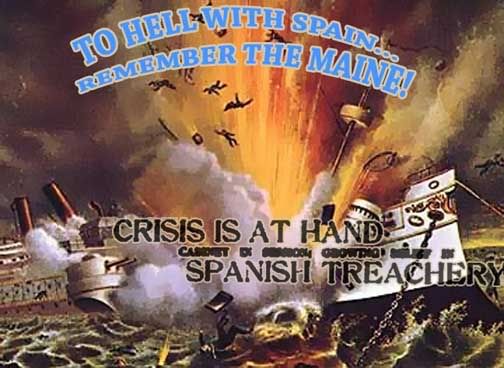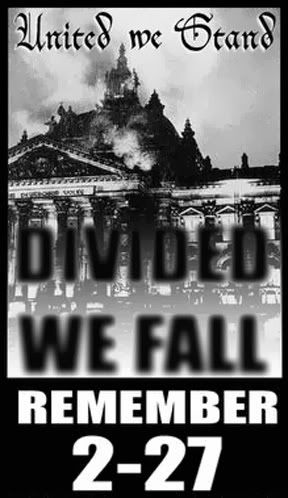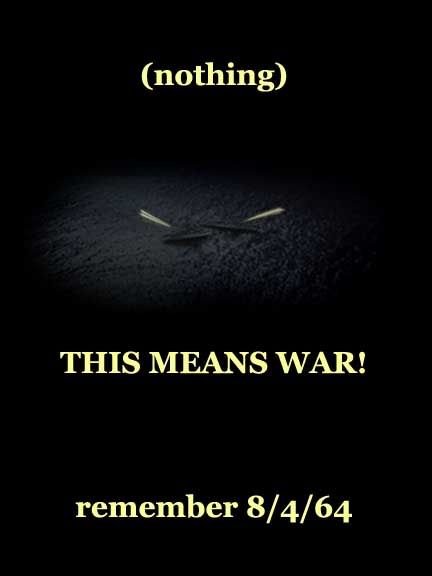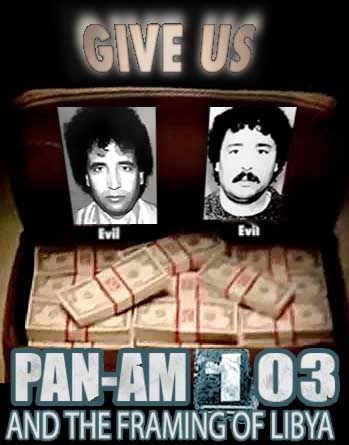Adam Larson / Caustic Logic
June 9 2009
PRIME-TIME MATERIAL
In his 1997 book Tonkin Gulf and the Escalation of the Vietnam War, Edwin E. Moïse made an excruciatingly thorough examination of all available information and found “no evidence,” nor any “reason to suppose” President Johnson or Defense Secretary MacNamara had any doubts about the reported incident during the crucial three days before passage of the Tonkin Gulf Resolution. [p 210] Of course the evidence was always ambiguous, contradictory, and unlikely at best, and all the doubts they needed were available to such high officials from the get-go. Instead, as Moïse writes:
“McGeorge Bundy has said that President Johnson decided at an early hour on August 4 – from his description of the timing, this might even have been before the shooting started, when all Johnson had were reports that the destroyers might be attacked – to use the incident as an occasion to get Congress to pass what was to become known as the Tonkin Gulf Resolution. […] Johnson had made up his mind. He had done so without first asking whether it was absolutely certain that an attack had actually occurred. [...] MacNamara [in seeking verification of the attack] was “asking on behalf of a president who had already committed himself to having a resolution and a speech and had the air time.”" [p 209]
Retaliatory bombing is serious, and should only be done based on verifiable, logical evidence of something to retaliate for. Very few if any doubts should be allowed, not “many,” as Commander Herrick warned along with his report. If you wait for daylight to look for evidence, as Herrick recommended, but find none, that should strengthen, not weaken, the doubts. Some solid visual contacts at least should be required, some damage to the ships verified as not caused by the other ship. Something resembling what the DRV was even capable of might be a good benchmark, and another that the August 4 reports failed to meet.
If one wants to avoid an honest mistake, a little time should be allowed to figure out questions like the above. But the President had his plan and his timeline; having been handed the attack reports conveniently at the working day’s beginning, he committed to go to war with it, to have strikes underway and announced live on national TV before too much of the nation was asleep for the night.
To fit this schedule, LBJ put immense pressure on the Defense Department to gather any verification possible and prepare counter-strikes for launch as early as possible. The military scrambled, complting a surface scan for evidence of a battle (negative), bringing in a second aircraft carrier, flying in extra jets, fueling, arming, target selection, pre-reconaissance, rules of engagement, so on. MacNamara and Johnson grew impatient as the evening deepened over the eastern seaboards and stated threatening their westward audiences. [p 214-16]
”AS I SPEAK…”
Once the air attacks were apparently, arguably, underway enough, the President was on the air at 11:37pm – about fourteen hours after first learning of the alleged attack. He announced to the world:
“[R]enewed hostile actions against United States ships on the high seas in the Gulf of Tonkin have today required me to order the military forces of the United States to take action in reply. […] That reply is being given as I speak to you tonight. Air action is now in execution…”
In fact, the attacks were about to begin, and LBJ jumping the gun to make the late news slot put the retaliatory mission in jeopardy. In fact, Vietnamese records reveal that whatever defenses they did erect against the air strikes were based on interception of this speech, which aired live well before the planes were in striking range, and just before the first radar readings were reported. [p 222]
That haste had only limited effect on the mission’s success and losses, but the brinksmanship is telling. Politics dictating military strategy Is nothing new, but it didn’t just set the timing of retaliation – it also guided what the military would have to “decide” about what happened in the Gulf that night.
VIETNAM BURNING OR WASHINGTON?
Once the first 24 hours had passed, it may have seemed to some that their job, aside from executing retaliation, was to find support for the vital war effort and the President’s snap decisions. There was certainly no order to this effect, but reality is capable of writing its own script once decided on and set in motion. The belli was rolling, and the casus would have to justify it, and the alternative may have looked rather ugly and dangerous to career military men.
Evidence was gathered, mostly at the hands of skilled Pentagon lawyers who “redebriefed” all classes of witnesses extracting legally admissible clues [p 186-187] Defense Department, Joint Chiefs, Pacific Fleet, etc. had their initial doubts, but allowed them to be quickly corrected by partial sightings, supporting intercepts (some just doctored together), more testimony and recollections and opinions leaning towards a genuine engagement, and most importantly “the flow.”
Johnson’s haste, which set the tempo of all this, might be effected by his famous engagement at the time in pressing domestic issues. All summer had been consumed with passing the Civil Rights Bill and related issues of the Freedom Summer era. Some in the south took it as a bit like a war, and three enemy agents – civil rights activists James Chaney, Andrew Goodman, and Michael Schwermer - had suspiciously disappeared in Mississippi in late June. News that their bodies had been found by the FBI task force there reached the President on the night of the 4th, as he was waiting to announce the air strikes. [p. 216]
The episode of their killing – as fictitiously portrayed in 1988 movie Mississippi Burning - offers an interesting metaphor for what happened in Washington a month later. It’s been a while since I’ve seen the film, but I recall in the dead of night, the assassins with their police powers catch the three men driving alone on a back road and get them pulled over, unjustly harass them on some bogus explanation, and then begin the brutal violence. It’s painfully obvious this is the kind of infringement that gets you in trouble if witnesses talk about it. At this point it becomes clear they have passed all possibility of turning back on the course they’ve set, and one participant drawls with sinister pleasure something to the effect “well, we’re in it now boys!” However it really happened, the killers shot all three men dead, hid the bodies, concoct alibis and flaunted the feds, essentially declaring a war they would eventually lose.
---
Source: Moïse, Edwin E. “Tonkin Gulf and the Escalation of the Vietnam War.” Chapel Hill (University of North Carolina Press). 1997. 255 pages













No comments:
Post a Comment